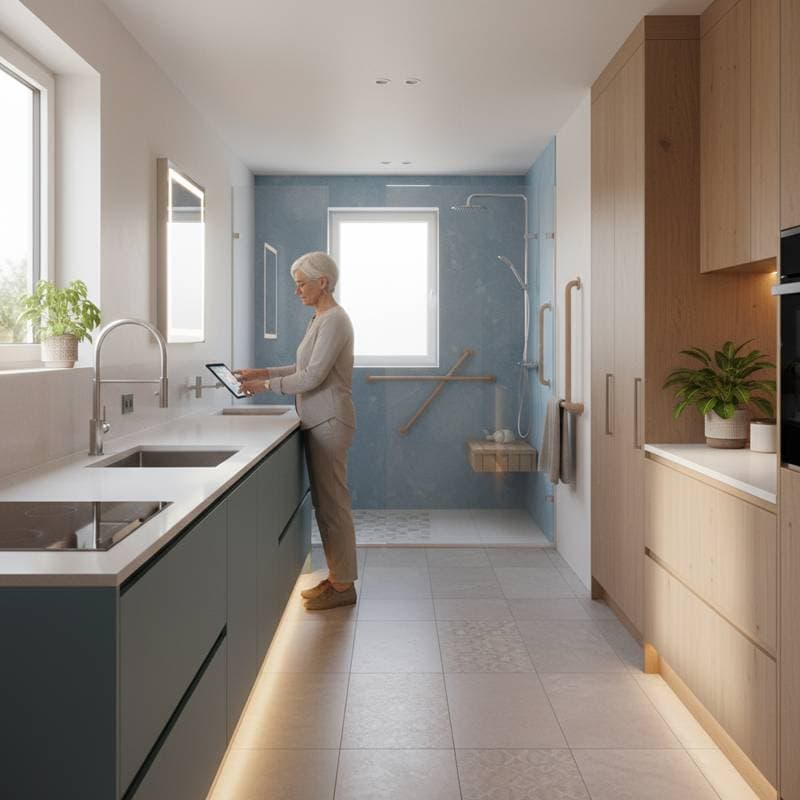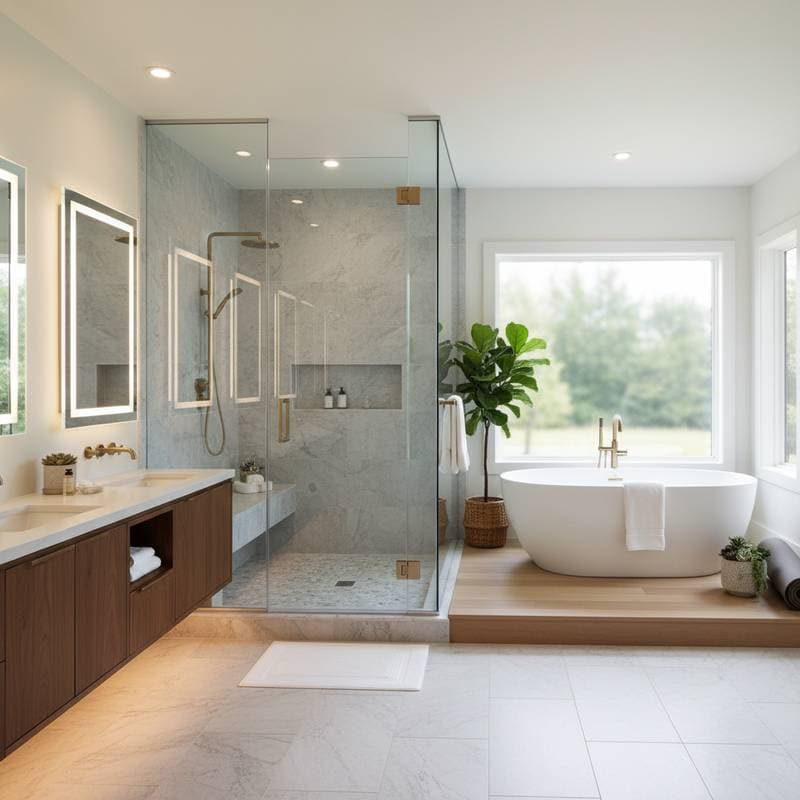Introduction to Wet Rooms
Wet rooms represent a shift in bathroom design, eliminating traditional tubs and showers in favor of fully waterproofed, open spaces. This layout allows water to flow freely across the entire floor, creating a spa-like environment that prioritizes accessibility and minimalism. In 2025, these designs gain popularity for their ability to adapt to aging-in-place needs and contemporary lifestyles.
Homeowners appreciate the barrier-free entry, which supports mobility aids and reduces fall risks. Architects favor wet rooms for their versatility in small or large spaces. As building materials advance, installation becomes more feasible, making wet rooms a practical upgrade for modern homes.
Key Benefits Over Traditional Layouts
Wet rooms offer advantages in safety, aesthetics, and efficiency that traditional bathrooms often lack. The level floor eliminates steps, providing safer navigation for all users. Open designs enhance natural light and visual flow, making spaces feel larger and more inviting.
Maintenance proves simpler without enclosures to clean. Water drains efficiently, minimizing puddles and mold growth. These features contribute to long-term durability, positioning wet rooms as a forward-thinking choice for 2025 renovations.
Understanding the Costs
Budgeting for a wet room requires consideration of several components. Costs vary based on size, materials, and location, but typical ranges provide a starting point.
- Tiling and Materials: Expect $3,000 to $8,000, depending on tile quality and waterproofing membranes.
- Fixtures and Fittings: Allocate $2,000 to $5,000 for showers, sinks, and hardware.
- Labor and Finishing: Plan for $3,000 to $6,000, covering installation and detailing.
Total expenses often fall between $8,000 and $19,000 for a standard 50-square-foot space. Factors like custom features or structural changes can increase this figure. Consulting local contractors yields precise estimates tailored to specific projects.
Return on Investment
Investing in a wet room yields significant financial returns. A quality installation recoups 60 to 70 percent of costs upon home sale. Premium elements, such as underfloor heating or eco-friendly fixtures, elevate resale value even further.
Buyers seek accessible, low-maintenance bathrooms in 2025. Wet rooms appeal to a broad demographic, including families and seniors. This versatility enhances marketability and speeds up sales processes.
Design and Style Choices
Effective design ensures a wet room functions beautifully and practically. Focus on elements that balance form and utility.
Tile Selection
Select non-slip porcelain or natural stone tiles suitable for wet areas. Larger formats minimize grout lines, simplifying upkeep. Extending the floor pattern to walls creates a unified, expansive appearance.
Consider color palettes that complement overall home decor. Neutral tones provide timeless appeal, while bold accents add personality. Always verify slip-resistance ratings to prioritize safety.
Drain and Slope Design
Linear drains offer a modern, streamlined profile and facilitate easy cleaning. Central drains suit classic setups but demand accurate sloping. Aim for a minimum 1-inch drop per 4 feet to direct water effectively.
Professional surveyors assess existing floors for optimal gradients. Proper sloping prevents standing water and preserves the room's integrity over time.
Glass and Partition Options
Incorporate a single glass panel or low wall to manage water spray while preserving openness. Frameless designs maintain unobstructed views and a seamless aesthetic.
Tempered glass resists breakage and requires minimal maintenance. Position partitions strategically to enhance privacy without compromising the spacious feel.
Lighting and Ventilation
Install recessed LED fixtures rated for damp locations to illuminate without intrusion. These provide even, energy-efficient light that highlights design details.
Pair with a powerful exhaust fan to control moisture levels. Adequate ventilation safeguards surfaces from condensation and mold, ensuring a healthy environment.
Maintenance and Longevity
Constructed correctly, wet rooms endure for decades with routine care. Focus on preventing buildup and inspecting seals regularly.
Sealed surfaces resist water damage, while quality materials withstand daily use. Annual checks identify potential issues early, extending the space's lifespan.
Maintenance Tips:
- Reseal grout and stone surfaces every one to two years.
- Clear drains weekly to prevent blockages.
- Apply neutral pH cleaners to avoid surface etching.
- Examine silicone seals periodically for wear and replace as needed.
Following these practices keeps the area secure, clean, and attractive indefinitely.
Money-Saving Strategies and ROI Boosters
Smart planning maximizes value while controlling expenses.
Combine Renovations
Integrate wet room work with broader home updates to consolidate labor and permitting fees. This approach streamlines workflows and reduces overall disruption.
Choose Durable Materials
Opt for porcelain tiles and corrosion-resistant fixtures. These withstand wear better than budget options, lowering replacement costs over time.
Optimize Space
Repurpose existing areas like powder rooms or utility spaces to minimize demolition. Thoughtful layouts deliver luxury in compact footprints.
Focus on Waterproofing First
Invest in reliable membranes and drainage to avoid future leaks. Cutting corners here leads to expensive fixes, undermining long-term savings.
When to Hire a Professional Contractor
Precision defines successful wet room projects. Engage specialists in accessible bathroom conversions with expertise in waterproofing.
Experienced teams navigate complexities like floor reinforcement and code compliance. Their knowledge ensures compliance and quality outcomes.
Key Questions to Ask
- How many wet room installations have you completed?
- Which waterproofing systems do you use, and what warranties apply?
- Can you supply itemized budgets and project schedules?
- Do you manage permits, inspections, and subcontractor coordination?
Skilled contractors detail processes from base preparation to final touches. They furnish material lists and guarantees for peace of mind.
Common Questions About Wet Rooms
Do wet rooms leak easily?
Proper waterproofing eliminates leak risks. Issues arise only from substandard installation of membranes or drains.
Can I install a wet room on an upper floor?
Yes, with structural reinforcements and drainage planning. Professionals evaluate feasibility to prevent complications.
Are wet rooms cold?
Open designs may feel drafty; counter this with radiant floor heating or towel warmers for consistent comfort.
Does a wet room increase humidity in the house?
Effective fans and seals contain moisture. Proper setup maintains balanced indoor air quality.
Can I retrofit my existing bathroom into a wet room?
Retrofitting works, though it involves modifications for waterproofing and slopes. Start with a site evaluation.
Enhancing Daily Comfort Through Wet Room Living
Adopting a wet room alters routines for the better. Simplified cleaning and intuitive access streamline mornings and evenings.
The design fosters relaxation, turning the bathroom into a serene retreat. It accommodates evolving needs, ensuring lasting satisfaction.
For remodelers eyeing 2025 upgrades, wet rooms deliver unmatched safety, style, and worth. Partner with experts to craft a space that elevates home life enduringly.











